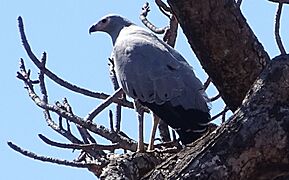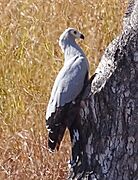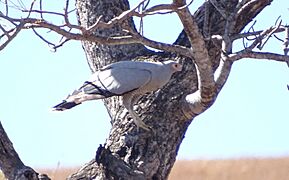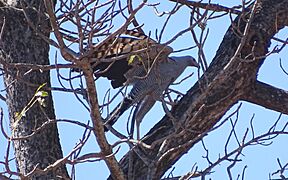Madagascar harrier-hawk facts for kids
The Madagascar harrier-hawk (Polyboroides radiatus) is a very large bird of prey that lives only on the island of Madagascar. It belongs to the same family as eagles and hawks, called Accipitridae.
Quick facts for kids Madagascar harrier-hawk |
|
|---|---|
 |
|
| near Mahaboboka | |
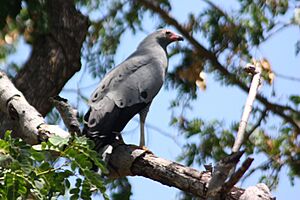 |
|
| in the Anjajavy Forest | |
| Conservation status | |
| Scientific classification |
Contents
What It Looks Like
The Madagascar harrier-hawk is a big bird of prey. It has long, wide wings that almost reach its tail when folded. Its tail is black with a wide grey band in the middle.
Adult birds are grey on their backs and have blackish flight feathers (the long feathers used for flying). Their undersides are white with many dark stripes on their chest, belly, and under their wings. The upper chest and throat are grey, matching their back, and they have a yellow face. Its beak is yellow with a black tip, and its legs are yellow.
Where It Lives
The Madagascar harrier-hawk is found in many parts of Madagascar. It is quite common, but you usually only see a few at a time. It is harder to find on the central plateau where many trees have been cut down. You can find this bird from sea level up to about 2,000 meters (6,560 feet) high.
Its Home
The Madagascar harrier-hawk lives in different kinds of places. It seems to prefer quiet lowland rainforests. However, it has also been seen in mountain rainforests, spiny deserts, and other wooded areas. This includes forests that have been changed by humans, and even tree farms.
Daily Life
Reproduction and Nesting
The Madagascar harrier-hawk builds a large, strong nest from sticks. It places its nest high up in a tree, usually between 18 to 30 meters (59 to 98 feet) off the ground. These birds have been seen nesting in September, October, and November.
Both the male and female birds take turns sitting on the eggs. The eggs hatch at different times, meaning some chicks are older than others. Sometimes, the older chicks hatch first and might be stronger, which can make it hard for the younger ones to survive. The young birds are ready to fly after about seven weeks. Once, a nest was even found inside a group of Sakalava weaver bird nests.
What It Eats
The Madagascar harrier-hawk eats many different things. It has been seen eating small birds, rodents, reptiles, insects, and even small lemurs.
Like the African harrier-hawk, this bird has a special trick with its legs. Its ankle joint can bend both forwards and backwards. This helps the bird use its feet to reach into hidden spots. It can pull out prey from holes in tree trunks, bird nests, and cracks in rocks. This unique ability helps it find food that other birds might miss.
Gallery



